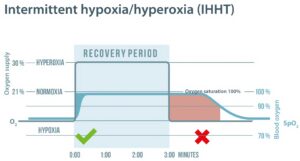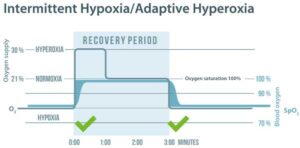At the beginning of the recovery phase, hyperoxic air is administered until the oxygen saturation in the blood reaches 99% (adjustable between 93% and 99% SpO2). The regeneration time is optimally utilized.
Normoxic air is then breathed for the remainder of the recovery period to prevent oxygen supersaturation. Thus, the subsequent training phase is not unnecessarily shortened. The oxygen saturation in the blood quickly drops back into the training range. The training stimulus of hypoxia is optimally utilized. In addition, oxidative stress is reduced to a minimum with simultaneous rapid saturation, since hyperoxia is only given until the set SpO2 value is reached.


